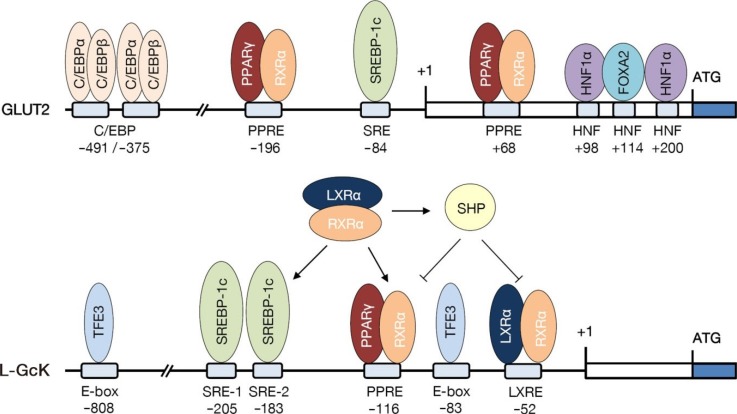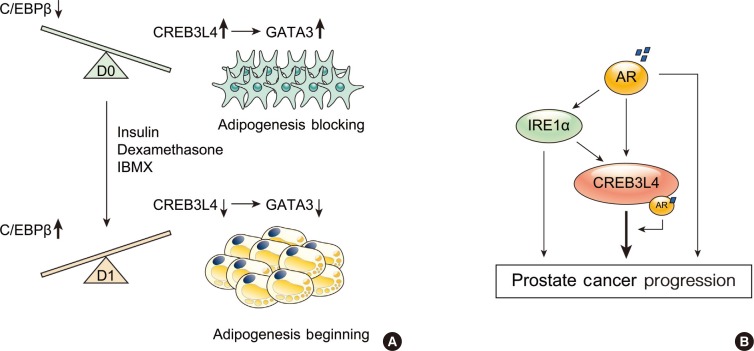Diabetes Metab J.
2018 Dec;42(6):465-471. 10.4093/dmj.2018.0116.
A Journey to Understand Glucose Homeostasis: Starting from Rat Glucose Transporter Type 2 Promoter Cloning to Hyperglycemia
- Affiliations
-
- 1Department of Biochemistry and Molecular Biology, Integrated Genomic Research Center for Metabolic Regulation, Yonsei University College of Medicine, Seoul, Korea. yha111@yuhs.ac
- KMID: 2449622
- DOI: http://doi.org/10.4093/dmj.2018.0116
Abstract
- My professional journey to understand the glucose homeostasis began in the 1990s, starting from cloning of the promoter region of glucose transporter type 2 (GLUT2) gene that led us to establish research foundation of my group. When I was a graduate student, I simply thought that hyperglycemia, a typical clinical manifestation of type 2 diabetes mellitus (T2DM), could be caused by a defect in the glucose transport system in the body. Thus, if a molecular mechanism controlling glucose transport system could be understood, treatment of T2DM could be possible. In the early 70s, hyperglycemia was thought to develop primarily due to a defect in the muscle and adipose tissue; thus, muscle/adipose tissue type glucose transporter (GLUT4) became a major research interest in the diabetology. However, glucose utilization occurs not only in muscle/adipose tissue but also in liver and brain. Thus, I was interested in the hepatic glucose transport system, where glucose storage and release are the most actively occurring.
Keyword
MeSH Terms
-
Adipogenesis
Adipose Tissue
Animals
Brain
Clone Cells*
Cloning, Organism*
Diabetes Mellitus, Type 2
Glucokinase
Gluconeogenesis
Glucose Transport Proteins, Facilitative*
Glucose Transporter Type 2*
Glucose*
Glycolysis
Homeostasis*
Humans
Hyperglycemia*
Liver
Promoter Regions, Genetic
Rats*
Transcription Factors
Glucokinase
Glucose
Glucose Transport Proteins, Facilitative
Glucose Transporter Type 2
Transcription Factors
Figure
Cited by 1 articles
-
Umbilical Cord-Mesenchymal Stem Cell-Conditioned Medium Improves Insulin Resistance in C2C12 Cell
Kyung-Soo Kim, Yeon Kyung Choi, Mi Jin Kim, Jung Wook Hwang, Kyunghoon Min, Sang Youn Jung, Soo-Kyung Kim, Yong-Soo Choi, Yong-Wook Cho
Diabetes Metab J. 2021;45(2):260-269. doi: 10.4093/dmj.2019.0191.
Reference
-
1. Schuit FC, Huypens P, Heimberg H, Pipeleers DG. Glucose sensing in pancreatic beta-cells: a model for the study of other glucose-regulated cells in gut, pancreas, and hypothalamus. Diabetes. 2001; 50:1–11.2. Ahn YH, Kim JW, Han GS, Lee BG, Kim YS. Cloning and characterization of rat pancreatic beta-cell/liver type glucose transporter gene: a unique exon/intron organization. Arch Biochem Biophys. 1995; 323:387–396. PMID: 7487103.3. Kim JW, Ahn YH. CCAAT/enhancer binding protein regulates the promoter activity of the rat GLUT2 glucose transporter gene in liver cells. Biochem J. 1998; 336(Pt 1):83–90. PMID: 9806888.
Article4. Cha JY, Kim H, Kim KS, Hur MW, Ahn Y. Identification of transacting factors responsible for the tissue-specific expression of human glucose transporter type 2 isoform gene. Cooperative role of hepatocyte nuclear factors 1alpha and 3beta. J Biol Chem. 2000; 275:18358–18365. PMID: 10748140.5. Cha JY, Kim HS, Kim HI, Im SS, Kim SY, Kim JW, Yeh BI, Ahn YH. Analysis of polymorphism of the GLUT2 promoter in NIDDM patients and its functional consequence to the promoter activity. Ann Clin Lab Sci. 2002; 32:114–122. PMID: 12017192.6. Nolan JJ, Ludvik B, Beerdsen P, Joyce M, Olefsky J. Improvement in glucose tolerance and insulin resistance in obese subjects treated with troglitazone. N Engl J Med. 1994; 331:1188–1193. PMID: 7935656.
Article7. Kim HI, Kim JW, Kim SH, Cha JY, Kim KS, Ahn YH. Identification and functional characterization of the peroxisomal proliferator response element in rat GLUT2 promoter. Diabetes. 2000; 49:1517–1524. PMID: 10969836.
Article8. Kim HI, Cha JY, Kim SY, Kim JW, Roh KJ, Seong JK, Lee NT, Choi KY, Kim KS, Ahn YH. Peroxisomal proliferator-activated receptor-gamma upregulates glucokinase gene expression in beta-cells. Diabetes. 2002; 51:676–685. PMID: 11872666.9. Kim HI, Ahn YH. Role of peroxisome proliferator-activated receptor-gamma in the glucose-sensing apparatus of liver and beta-cells. Diabetes. 2004; 53(Suppl 1):S60–S65. PMID: 14749267.10. Kim SY, Kim HI, Park SK, Im SS, Li T, Cheon HG, Ahn YH. Liver glucokinase can be activated by peroxisome proliferator-activated receptor-gamma. Diabetes. 2004; 53(Suppl 1):S66–S70. PMID: 14749268.11. Kim TH, Kim H, Park JM, Im SS, Bae JS, Kim MY, Yoon HG, Cha JY, Kim KS, Ahn YH. Interrelationship between liver X receptor alpha, sterol regulatory element-binding protein-1c, peroxisome proliferator-activated receptor gamma, and small heterodimer partner in the transcriptional regulation of glucokinase gene expression in liver. J Biol Chem. 2009; 284:15071–15083. PMID: 19366697.12. Kim SY, Kim HI, Kim TH, Im SS, Park SK, Lee IK, Kim KS, Ahn YH. SREBP-1c mediates the insulin-dependent hepatic glucokinase expression. J Biol Chem. 2004; 279:30823–30829. PMID: 15123649.
Article13. Im SS, Kang SY, Kim SY, Kim HI, Kim JW, Kim KS, Ahn YH. Glucose-stimulated upregulation of GLUT2 gene is mediated by sterol response element-binding protein-1c in the hepatocytes. Diabetes. 2005; 54:1684–1691. PMID: 15919789.
Article14. Im SS, Kwon SK, Kang SY, Kim TH, Kim HI, Hur MW, Kim KS, Ahn YH. Regulation of GLUT4 gene expression by SREBP-1c in adipocytes. Biochem J. 2006; 399:131–139. PMID: 16787385.
Article15. Nakagawa Y, Shimano H, Yoshikawa T, Ide T, Tamura M, Furusawa M, Yamamoto T, Inoue N, Matsuzaka T, Takahashi A, Hasty AH, Suzuki H, Sone H, Toyoshima H, Yahagi N, Yamada N. TFE3 transcriptionally activates hepatic IRS-2, participates in insulin signaling and ameliorates diabetes. Nat Med. 2006; 12:107–113. PMID: 16327801.
Article16. Kim MY, Jo SH, Park JM, Kim TH, Im SS, Ahn YH. Adenovirus-mediated overexpression of Tcfe3 ameliorates hyperglycaemia in a mouse model of diabetes by upregulating glucokinase in the liver. Diabetologia. 2013; 56:635–643. PMID: 23269357.
Article17. Kersten S, Seydoux J, Peters JM, Gonzalez FJ, Desvergne B, Wahli W. Peroxisome proliferator-activated receptor alpha mediates the adaptive response to fasting. J Clin Invest. 1999; 103:1489–1498. PMID: 10359558.18. Im SS, Kim MY, Kwon SK, Kim TH, Bae JS, Kim H, Kim KS, Oh GT, Ahn YH. Peroxisome proliferator-activated receptor {alpha} is responsible for the up-regulation of hepatic glucose-6-phosphatase gene expression in fasting and db/db mice. J Biol Chem. 2011; 286:1157–1164. PMID: 21081500.19. Park JM, Kim MY, Kim TH, Min DK, Yang GE, Ahn YH. Prolactin regulatory element-binding (PREB) protein regulates hepatic glucose homeostasis. Biochim Biophys Acta. 2018; 1864(6 Pt A):2097–2107.
Article20. Niswender KD, Shiota M, Postic C, Cherrington AD, Magnuson MA. Effects of increased glucokinase gene copy number on glucose homeostasis and hepatic glucose metabolism. J Biol Chem. 1997; 272:22570–22575. PMID: 9278411.
Article21. Park JM, Kim TH, Jo SH, Kim MY, Ahn YH. Acetylation of glucokinase regulatory protein decreases glucose metabolism by suppressing glucokinase activity. Sci Rep. 2015; 5:17395. PMID: 26620281.
Article22. Park JM, Kim TH, Bae JS, Kim MY, Kim KS, Ahn YH. Role of resveratrol in FOXO1-mediated gluconeogenic gene expression in the liver. Biochem Biophys Res Commun. 2010; 403:329–334. PMID: 21078299.
Article23. Jo SH, Kim MY, Park JM, Kim TH, Ahn YH. Txnip contributes to impaired glucose tolerance by upregulating the expression of genes involved in hepatic gluconeogenesis in mice. Diabetologia. 2013; 56:2723–2732. PMID: 24037087.
Article24. Kim TH, Jo SH, Choi H, Park JM, Kim MY, Nojima H, Kim JW, Ahn YH. Identification of Creb3l4 as an essential negative regulator of adipogenesis. Cell Death Dis. 2014; 5:e1527. PMID: 25412305.
Article



